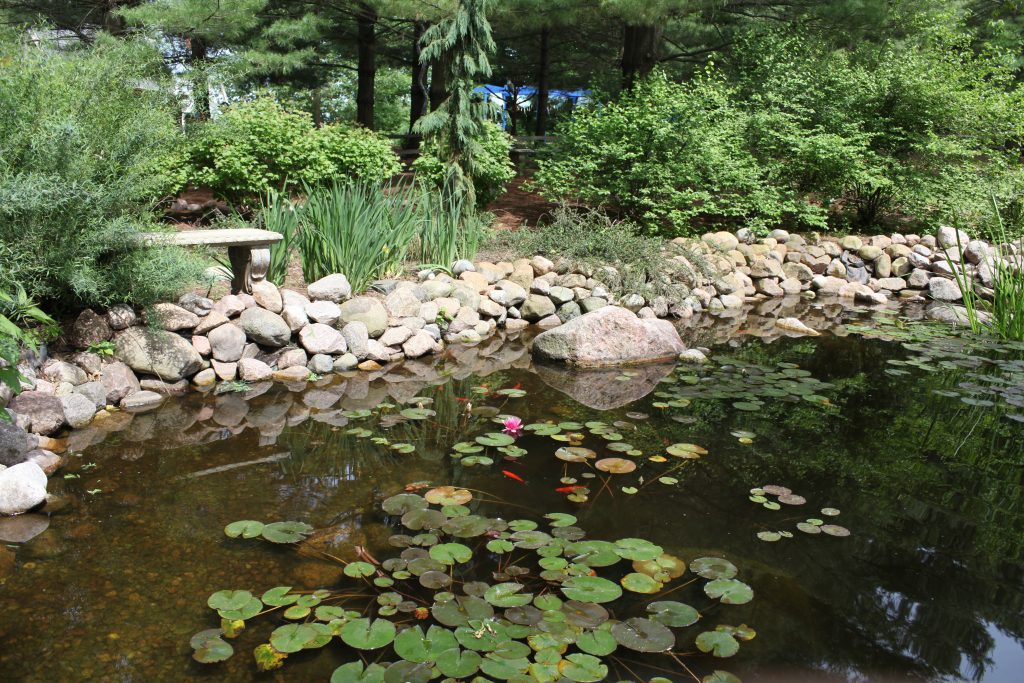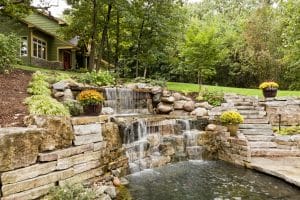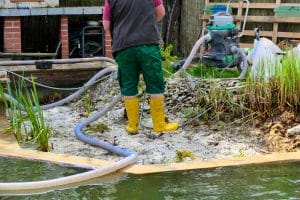
What Is an Ecosystem Pond and How Is It Different? A Simple Guide
An ecosystem pond is a self-sustaining aquatic environment where plants, animals, and microorganisms work together to maintain balance. Unlike traditional ponds, ecosystem ponds require minimal maintenance and mimic natural water bodies. In this article, we will explore what is an ecosystem pond and how it is different, highlighting what makes ecosystem ponds unique and how they differ from conventional ponds.
Key Takeaways
Ecosystem ponds are self-sustaining environments that promote biodiversity through the interaction of various biotic and abiotic components, requiring minimal maintenance compared to traditional ponds.
Maintaining water quality is crucial in ecosystem ponds, as it prevents issues like algal blooms; this is achieved through a balanced nutrient cycle and the presence of beneficial bacteria and aquatic plants.
The health of an ecosystem pond relies on its inhabitants, including fish, frogs, and plants, which contribute to nutrient cycling, water clarity, and the overall ecological balance.
Understanding Ecosystem Ponds
An ecosystem pond functions as a living, self-sustaining freshwater system. In this setup, an array of organisms depend on each other for survival within the ecosystem. Ecosystem ponds differ from traditional ponds in that they are engineered to replicate natural aquatic environments, thus nurturing equilibrium among diverse life forms and fostering biodiversity by enabling various species to flourish through their interactions.
Biotic elements such as fish, frogs, beneficial bacteria, and aquatic plants coexist with abiotic components like the water’s quality and its nutrient content in a pond’s ecosystem. These factors collectively forge a habitat capable of sustaining itself with minimal human intervention while offering substantial ecological advantages including natural filtration processes and elimination of pollutants.
We will delve into examining the integral constituents of a pond’s ecosystem along with their respective roles in preserving its balance and vitality.
Components of a Pond’s Ecosystem
The ecosystem within a pond is an intricate network of various integral components that work synergistically to maintain equilibrium. These vital elements are:
Frogs
Fish
Aquatic plants
Beneficial bacteria
Microscopic life forms
Photosynthesis enables aquatic plants to produce energy, which in turn provides oxygen and sustains additional living organisms, thereby establishing these plants as fundamental producers within the pond’s ecological system.
Within this aquatic ecosystem, consumers are categorized into three levels: primary consumers consist of organisms such as zooplankton, small fish represent secondary consumers, while larger fish and amphibians act as tertiary consumers.
Additional essential factors contributing to the health and efficacy of an ecosystem pond include filters along with algae plus rocks and gravel. Each plays a pivotal role in supporting the vitality of the entire pond habitat.
Differences from Traditional Ponds
Ecosystem ponds are distinct from conventional garden ponds in terms of their maintenance demands. A healthy ecosystem pond, carefully designed to be self-sustaining, necessitates little upkeep and infrequent water quality testing. In contrast, standard garden ponds typically require more regular care and management efforts to maintain cleanliness and equilibrium.
These types of ponds promote a natural balance within the species inhabiting them, creating an environment rich in biodiversity. This inherent harmony serves as a defense against common issues like algal blooms and degraded water quality. Having an ecosystem pond translates into a sustainable choice that is beneficial for nature when considering options for incorporating ponds into gardens.
Importance of Water Quality
Ensuring the health and balance of an ecosystem pond hinges on maintaining high-quality water. Challenges such as algal blooms, unpleasant smells, and potential fish deaths can emerge from poor water conditions. The equilibrium within a pond’s ecosystem is established by the synergistic relationship between filtration systems, aquatic vegetation, fish populations, and rocks with gravel, all essential components that collectively work to purify the water. Aquatic plants naturally sequester surplus nutrients, which might otherwise fuel algae proliferation. Meanwhile, beneficial bacteria decompose organic waste and debris providing vital nutrients for plant life.
For a thriving pond environment to exist, there must be ongoing interaction among its constituents ensuring clear waters while nurturing diverse biological communities. This dynamic entails fishes consuming plant matter then producing waste products. Subsequently these wastes are degraded by bacterial action rendering them into absorbable forms for plants’ uptake—this constitutes nature’s own means of filtering out impurities thereby precipitating stable ecological surroundings.
In what follows, we’ll delve into various methods applicable for filtering water in ecosystems ponds alongside underscoring how crucial managing nutrient levels is in thwarting excess algae formation.
Filtration Methods
Maintaining water quality and clarity in ecosystem ponds hinges on effective filtration practices, which encompass mechanical, biological, or integrated approaches.
Systems for mechanical filtration like skimmers and filter boxes are instrumental in curbing debris build-up. They contribute to the preservation of clear water by actively extracting particulates. In contrast, biological filters play a vital role by fostering growth environments for beneficial bacteria that aid in decomposing waste substances and improving water quality.
Implementing both these methods of filtration is pivotal to achieving equilibrium within a pond’s ecosystem. This integration ensures ongoing purification of the water while nurturing essential bacterial communities.
Balancing Nutrients
Maintaining equilibrium in the nutrient content of an ecosystem pond is critical for avoiding problems such as eutrophication and algal overgrowth. When excess nutrients accumulate, they can stimulate algal blooms that subsequently reduce oxygen concentrations, negatively impacting the organisms within the pond.
Vegetation around the edges of a pond plays an integral part by assimilating surplus nutrients, which enhances water quality and contributes to sustaining a harmonious ecosystem. Beneficial bacteria along with fungi act as decomposers. These organisms are crucial in breaking down organic matter and returning nutrients to their natural cycle within the ecosystem, preventing harmful accumulations.
Preserving this delicate balance of nutrient cycles is pivotal for ensuring that a pond’s environment remains healthy and flourishes.
Role of Aquatic Plants
The health and efficiency of a pond ecosystem are significantly influenced by the presence of aquatic plants. Serving as primary producers, these plants engage in photosynthesis to produce energy, which supplies oxygen and nourishment for residents like fish and frogs within the pond. They act as organic purifiers that absorb excess nutrients from the water, thus preventing algal overgrowth. Aquatic flora encompasses various types such as submerged species, floating varieties, emerging classes, and those occupying marginal zones – each playing distinct roles within their aquatic environment.
A diverse selection of aquatic vegetation is key when establishing an ecosystem pond. It promotes adequate oxygen levels while fostering a balanced ecological system. Not only do they improve overall water clarity, but also offer vital shelter and feeding opportunities for amphibian populations alongside other wildlife dwelling in or around the waterbody.
Next up: A discussion on how these essential underwater plant communities enhance purity through natural filtration processes providing life-giving oxygenation, all while creating conducive living spaces for assorted creatures inhabiting ponds ecosystems.
Cleaning and Oxygenating
Aquatic plants play a crucial role in the pond ecosystem by producing oxygen necessary for aquatic life through photosynthesis. They take in carbon dioxide and expel oxygen, thus regulating oxygen levels and supporting overall water quality.
In turn, this released oxygen is critical to maintaining a healthy pond environment where fish and other aquatic organisms can thrive. Acting as natural purifiers, these plants are instrumental in preserving clean and vibrant conditions within the pond’s waters.
Providing Habitat
Aquatic plants play a vital role in offering necessary habitats for diverse organisms, enriching the biodiversity of the pond ecosystem. The shallow regions around the edges of the pond, known as marginal zones, boast an abundance of plant life and are pivotal in providing crucial environments for various wildlife species.
Plants along the shoreline take up nitrogen and other excess nutrients from their surroundings, aiding in preserving water quality and fostering a thriving aquatic ecosystem. This varied vegetation not only acts as nourishment, but also offers shelter and reproductive areas for inhabitants like fish, frogs, and myriad other creatures.
Through establishing a nurturing habitat for wildlife within these waterscapes, aquatic plants contribute significantly to sustaining equilibrium in a flourishing pond ecosystem.
Beneficial Bacteria and Decomposers
In the maintenance of an ecosystem pond’s health and equilibrium, beneficial bacteria and decomposers are indispensable. These microorganisms excel at transforming waste material and organic remnants into nutrients accessible for plant consumption. Biological filtration systems like waterfall filters offer a growth substrate for these advantageous bacteria to establish themselves, which in turn boosts their efficiency in purifying water quality. Meanwhile, decomposers such as fungi and specific types of bacteria dedicate themselves to the breakdown of deceased organisms, expired plant matter, and other natural detritus. This process recycles critical nutrients within the ecosystem while simultaneously averting the accumulation of harmful substances.
Gravel scattered across the bottom of ponds serves as an imperative refuge for these valuable microscopic life forms. Its inclusion is key to sustaining ecological harmony within pond settings.
The continuous presence of beneficial bacteria alongside decomposing agents is essential when it comes to preserving a pristine aquatic environment inside a pond system. Their activity plays pivotal roles: they control nutrient concentrations adeptly which diminishes occurrences harmful algal outbreaks might inflict while ensuring smooth operational aspects throughout varied sections that comprise any given ecosystem-based pond structure.
Subsequently outlined will be Details regarding how these helpful bacterial colonies come about together with scrutinizing their consequential effects pertaining directly to attributes associated with overall water conditions found within ecosystems labeled ‘ponds’.
Colonization Process
Within the confines of an ecosystem pond, stages mark the progression of beneficial bacteria colonization. Surfaces throughout the pond environment—such as rocks, gravel, and filter media—begin to develop microbial films at first. In a period ranging from two weeks up to six weeks, these colonies of bacteria reach maturity and embark on their crucial role in decomposing waste material while enhancing water quality.
Such bacterial settlement is critical for fostering a harmonious and self-sufficient ecosystem within the pond. This process secures that these advantageous microbes are able to significantly aid in maintaining the well-being of the entire aquatic system.
Impact on Water Quality
Microorganisms such as decomposers and beneficial bacteria are essential in preserving the water quality of an ecosystem pond. They achieve this by digesting organic materials and absorbing nutrients from the water, thus enhancing its clarity and decreasing the likelihood of occurrences like green water or detrimental algal blooms.
The importance of biological filters is underscored by their function as habitats for colonies of these crucial bacteria. These filters aid in the removal of surplus nutrients, thereby promoting a purified and equilibrium-sustaining environment within the pond. For sustaining a clean aquatic habitat and preserving ecological balance within an ecosystem pond, both decomposers’ activities and beneficial bacterial functions are indispensable.
Fish and Other Pond Inhabitants
All the creatures living in a pond, such as fish and other aquatic life forms, are crucial to maintaining a balanced ecosystem within that waterbody. A variety of animals like koi fish, different species of pond-dwelling fish, turtles, birds, and frogs all play important roles in sustaining the health and equilibrium of the pond environment. While these fish consume algae, which helps regulate its growth, they also aid with circulation by stirring up water when they swim around, and they contribute waste material which is integral for nutrient cycling. Frogs alongside salamanders and turtles enrich biodiversity as both predators and prey within their food web.
This biological interplay among organisms ensures a dynamic balance within an ecosystem pond fostering diverse populations. By offering food sources along with shelter options, these ponds become hotspots for attracting myriad wildlife varieties thus amplifying one’s pleasure from natural surroundings outdoors.
We shall delve into how fish specifically influence the functionality of this type of freshwater habitat while considering that it’s only through nurturing a well-adjusted ecological system can an ecosystem pond successfully beckon assorted fauna throughout its existence.
Fish Contributions
In an ecosystem pond, fish are pivotal in preserving the ecological balance. They manage algae levels by feeding on them, thereby enhancing water transparency and mitigating the threat of algal blooms. Specifically, koi fish excel at consuming algae and circulating still waters to avert accumulation of noxious materials.
These aquatic creatures aid in maintaining pond hygiene through their consumption of debris coupled with waste production that nourishes plant life. Incorporating fish into a garden pond elevates not just its visual charm, but also maintains an equilibrium within its ecosystem.
Wildlife Attraction
An ecosystem pond that maintains a balanced ecology becomes an attractive spot for different wildlife forms, thereby increasing the area’s biodiversity and offering multiple species with essential habitats. The inclusion of rocks and gravel within the pond provides crucial hiding places for assorted organisms, which fosters diversity in this aquatic environment.
Serving as crucial stopover points and reservoirs for migratory birds among other animals, ponds provide them with necessities like protection, sustenance, and breeding grounds. When such ecosystems offer fitting habitats while maintaining equilibrium among its components, they naturally lure various creatures including birds and amphibians. This enhances not just the visual appeal, but also contributes significantly to the ecological value of any given locale.
Rocks and Gravel
Natural stones and gravel serve as critical components of an ecosystem pond, providing both aesthetic enhancement and essential functionality. These materials safeguard the pond liner against ultraviolet damage while also helping to prevent erosion, contributing to the pond’s durability. Rocks and gravel expand the available surface area for beneficial bacteria colonization, which is vital in sustaining the health of a pond’s ecosystem by processing waste and cycling nutrients.
Integrating an assortment of stones in varying sizes and configurations not only elevates the visual appeal but also promotes a more authentic-looking aquatic environment. Utilizing gravels with assorted hues and textures can effectively merge your pond into its natural surroundings, increasing its overall beauty.
Beyond beautifying a pond, rocks and gravel are pivotal in fostering a robust ecosystem. They offer shelter for myriad microscopic organisms as well as small creatures that call the pond home. Following this section, we will delve deeper into how these elements contribute decoratively along with their importance in creating living spaces within ponds.
Natural Decoration
Rocks and gravel play a crucial role in maintaining a balanced ecosystem within the pond by providing an ideal environment for beneficial bacteria to thrive. These elements are not only vital for sustaining the overall health of the ecosystem pond, but also serve as protection for the liners beneath them.
The assortment of rocks, with their different sizes and forms, contribute to achieving a natural appearance at the bottom of your garden pond. Employing various hues and textures of gravel can integrate seamlessly with your landscape design, thus elevating both its beauty and cohesion within your garden setting.
Habitat Creation
The composition of rocks and gravel within the pond ecosystem functions as a haven for diminutive organisms, offering them protection from predators and a place to seek shelter. These elements provide an infrastructure that makes it more convenient for inhabitants of the pond to navigate their entry and departure with safety.
Establishing an appropriate environment is essential for sustaining the lives of organisms in the pond by affording them concealment and defense against predatory threats. In essence, integrating rocks and gravel into this setting bolsters habitat development, fostering a vibrant and richly varied ecosystem within the pond.
Common Challenges and Solutions
Maintaining an ecosystem pond comes with its own set of challenges, but understanding these issues and knowing how to address them can help ensure a healthy and balanced pond environment. Poor water quality can result in problems such as algae blooms, foul odors, and fish mortality. Pollutants and excess nutrients from runoff, dead vegetation, and organic waste can lead to nutrient loading, causing algal blooms that deplete oxygen and harm pond species.
Seasonal challenges, such as ponds drying up, can also affect small and microscopic animals. Regular maintenance, including cleaning the bog filter and stream, monitoring for dead organic matter, and adapting routines to seasonal changes, is essential for preserving the ecological balance of pond ecosystems.
By addressing these common challenges, pond owners can maintain a thriving ecosystem pond. We will now explore specific solutions for controlling algae and preventing overpopulation.
Algae Control
Pond owners frequently grapple with excessive algae growth, which is a common issue in these water bodies. To regulate the proliferation of algae, it’s crucial to achieve the equilibrium that nature designed. Introducing additional plants into the pond helps suppress algal bloom by depriving algae of their nourishment.
Initially employing algaecides and then transitioning to natural remedies can be an effective strategy for controlling both filamentous and planktonic forms of algae. Adopting this approach enables those who own ponds to preserve clear water while sustaining a balanced ecosystem.
Preventing Overpopulation
Ensuring that the fish and plant populations within an ecosystem pond are kept in check is essential for preserving both water clarity and a harmonious balance within the ecosystem. An overabundance of fish can result in an accumulation of fish waste which has the potential to clog plants and filtration systems, leading to turbid waters. In parallel, a surplus of plants might also generate excessive waste material that can obstruct filters and degrade water quality.
By regulating the quantity of fish and vegetation, pond owners can diminish maintenance requirements while fostering a robust, well-balanced habitat. Constant vigilance over the numbers of each type of pond inhabitant allows those who manage these ecosystems to avoid issues related to overpopulation thus ensuring their ponds remain vibrant centers for aquatic life.
Creating and Maintaining Your Ecosystem Pond
Establishing your own ecosystem pond can be an enriching experience. For the construction of such a pond, it’s advisable to use butyl rubber liners due to their resilience and ability to prevent leaks effectively, thus guaranteeing longevity for your pond. To set up the pond initially, select an area that provides an optimal mix of sunlight and shade, then populate with diverse aquatic plants which are crucial for oxygen provision and creating a balanced ecosystem within the water body. Ecosystem ponds come in various sizes. They typically start from 2.4 meters by 3 meters, reaching up to 6 meters by 6 meters in dimension, while the common size is usually between 100-200 square feet featuring about two feet depth at its deepest part.
The continued care required for an ecosystem pond is less intensive than that needed for conventional ponds. Introduce indigenous plant species into this environment approximately one or two weeks after adding water encourages habitation by local fauna and aids in sustaining ecological equilibrium.
To ensure enduring health and stability within your eco-friendly water habitat, routine upkeep should consist of sporadic filter cleansings as well as vigilance regarding the quality of water along with periodic adjustments tailored to each season’s requirements. Adhering strictly to these management principles will enable you not only establish but also perpetuate a vibrant ecosystem pond, augmenting both aesthetics as well space utility while concurrently accommodating native wildlife species.
Initial Setup
Establishing an ecosystem pond requires thoughtful planning and attention to various key aspects. It’s essential when choosing a site for the pond to find a spot that benefits from both sunlight and shade during different times of the day, as this balance is crucial for nurturing aquatic plants while keeping algae growth under control.
The dimensions of your pond should be in harmony with the size of your garden, falling within 2.4 meters by 3 meters up to 6 meters by 6 meters, with most ponds averaging between 100-200 square feet in area and reaching depths up to two feet at their deepest point. Introducing a diverse selection of aquatic plants tailored to fit the scale and specific conditions of your pond will contribute significantly towards cultivating a stable ecosystem.
Ongoing Maintenance
It is crucial to perform consistent maintenance on an ecosystem pond to preserve its vitality and equilibrium over time. About one or two weeks following the introduction of water into the pond, it’s advisable to plant native species that bolster support for indigenous wildlife and contribute to sustaining the ecological harmony.
Routine upkeep activities such as cleaning filters periodically, keeping a watchful eye on water quality, and applying changes in accordance with the seasons are necessary. An ecosystem pond minimizes both effort and expenses required for its upkeep, thus providing you with a vibrant and attractive feature in your garden that requires little hassle to maintain.
Enjoying Your Garden Pond
An aquatic haven within your garden, the pond acts as an ever-evolving centerpiece that beautifies the landscape with each passing season. Utilizing rocks and gravel not only augments the allure of your water feature, but also offers protection to its liner, fostering a picturesque and serene setting for your garden retreat. The soothing echoes from water elements like cascades or brooks contribute to tranquility, turning the space around your pond into an oasis ideal for repose and meditation.
To enhance visual pleasure, a garden pond is instrumental in nurturing diverse wildlife populations that add ecological richness to your green space. It becomes a sanctuary where fish glide gracefully beneath surfaces dotted with lily pads while birds flit overhead and frogs seek refuge along the banks—an ecosystem teeming with life that draws nature’s wonder right into one’s backyard.
Reveling in moments by this microcosm provides countless pleasures—from witnessing aquatic flora burst forth in seasonal splendor to observing contented swimmers navigate through verdant vegetation—each experience deepens one’s bond with natural surroundings offered by having such vibrant biodiversity anchored at the heart of their personal outdoor escape.
Seasonal Highlights
At the height of the pond season, those who own ponds may witness a lively spectacle as plants burst into bloom and wildlife abounds. The blossoming of water lilies contributes aesthetic appeal and hue to the pond, complemented by content fish that frolic among them, as well as frogs and birds that frequent this thriving ecosystem.
This cyclical evolution transforms a simple garden feature into an ever-changing tableau that captivates throughout the seasons. It not only offers enduring pleasure, but also fosters an intimate bond with nature’s rhythms.
Enhancing Outdoor Living
Integrating a pond with aquatic plants and water features into your garden can transform it into an oasis of calm, perfect for leisurely activities or hosting social events. This inclusion nurtures a peaceful atmosphere and deepens one’s bond with the natural world, elevating the ambience of your outdoor area.
The addition of a garden pond acts as an inviting sanctuary ideal for relaxation, contemplation, or convivial gatherings in your open-air space. It serves as an asset that enriches the functionality and aesthetic appeal of your property.
Summary
In summary, ecosystem ponds offer a unique and sustainable way to enhance your garden while supporting local biodiversity. By understanding the components of a pond’s ecosystem, the importance of water quality, and the roles of aquatic plants, beneficial bacteria, and pond inhabitants, you can create a thriving and balanced pond environment. Regular maintenance and mindful management of nutrients and population levels are essential for maintaining a healthy ecosystem pond. Embrace the beauty and tranquility of a garden pond, and enjoy the endless benefits it brings to your outdoor living space.
Frequently Asked Questions
What is an ecosystem pond?
An ecosystem pond is a self-sustaining water feature that closely resembles natural water bodies, fostering diverse plants, animals, and microorganisms.
Such ponds effectively maintain ecological balance and contribute to local biodiversity.
How do aquatic plants help maintain water quality in a pond?
Aquatic plants are essential for maintaining water quality in a pond, as they absorb excess nutrients and produce oxygen through photosynthesis, effectively acting as natural filters.
This process contributes significantly to cleaner water.
What are the benefits of having fish in a pond ecosystem?
Having fish in a pond ecosystem is beneficial as they control algae growth, enhance water movement, and their waste acts as a nutrient source for aquatic plants.
These interactions maintain a balanced and healthy ecosystem.
Why is balancing nutrients important in a pond ecosystem?
Balancing nutrients is crucial in a pond ecosystem as it prevents harmful algal blooms and maintains water quality, thus supporting the health of all organisms within the system.
Ensuring proper nutrient levels facilitates a sustainable and thriving aquatic environment.
What maintenance is required for an ecosystem pond?
To ensure the health of an ecosystem pond, it is essential to perform minimal maintenance activities, including occasional filter cleaning, regular water quality monitoring, and making seasonal adjustments.
Consistent attention to these tasks will help maintain a balanced and thriving pond environment.



